YAMAHA FX SVHO 2021 Owners Manual
Manufacturer: YAMAHA, Model Year: 2021, Model line: FX SVHO, Model: YAMAHA FX SVHO 2021Pages: 116, PDF Size: 5.03 MB
Page 101 of 116

Maintenance
94
*1: Whichever comes first.
*2: Check every 200 hours.
Perform the pre-operation checks and post-operation checks before performing periodic
maintenance.
Exhaust systemCheck for exhaust leak-
age, and check hoses and
clamps √
—
Breather hose Check breather hose and
clamps
√
—
Impeller Check for bends, dam-
age, and foreign material
√
—
Jet thrust nozzle Check movement, and lu-
bricate
√
—
Jet vacuum bilge Check hoses for clogs
and damage, check
clamps, and clean bilge
strainer
√
—
Stern drain plugs Check O-rings √—
Anode Check for corrosion, and
clean
√
*2 —
Valve clearance Check and adjust √ *2 —
Rubber coupling Check for cracks, inden-
tations, looseness, and
noise √
—
Engine mount Check for damage and
peeling
√
—
Item Operation
Initial Thereafter every
Page
10 hours 50 hours
or 12
months *1 100
hours or 12
months *1 200
hours or 24
months *1
UF3X72E0.book Page 94 Friday, May 29, 2020 10:09 AM
Page 102 of 116
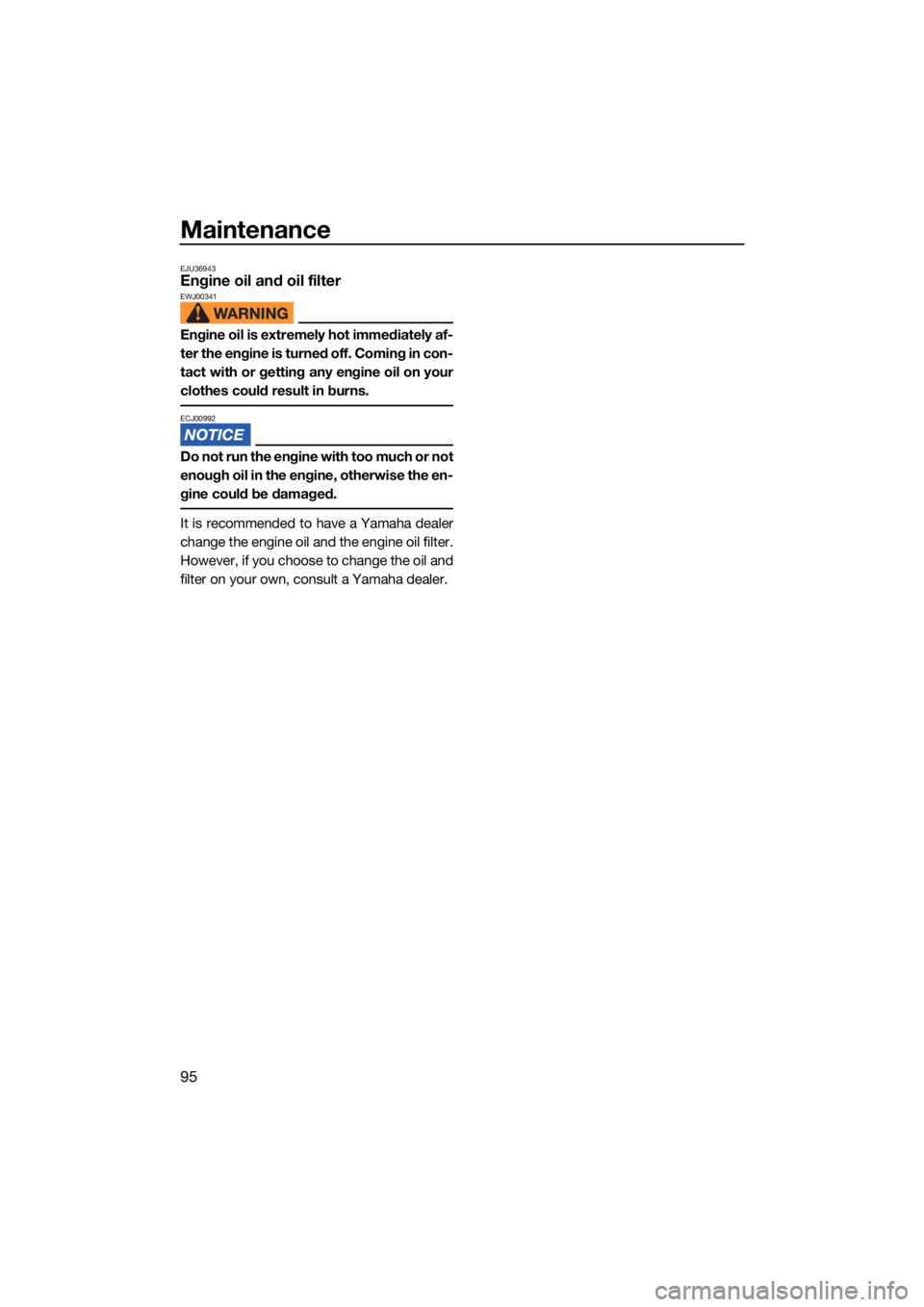
Maintenance
95
EJU36943Engine oil and oil filterEWJ00341
Engine oil is extremely hot immediately af-
ter the engine is turned off. Coming in con-
tact with or getting any engine oil on your
clothes could result in burns.
ECJ00992
Do not run the engine with too much or not
enough oil in the engine, otherwise the en-
gine could be damaged.
It is recommended to have a Yamaha dealer
change the engine oil and the engine oil filter.
However, if you choose to change the oil and
filter on your own, consult a Yamaha dealer.
UF3X72E0.book Page 95 Friday, May 29, 2020 10:09 AM
Page 103 of 116
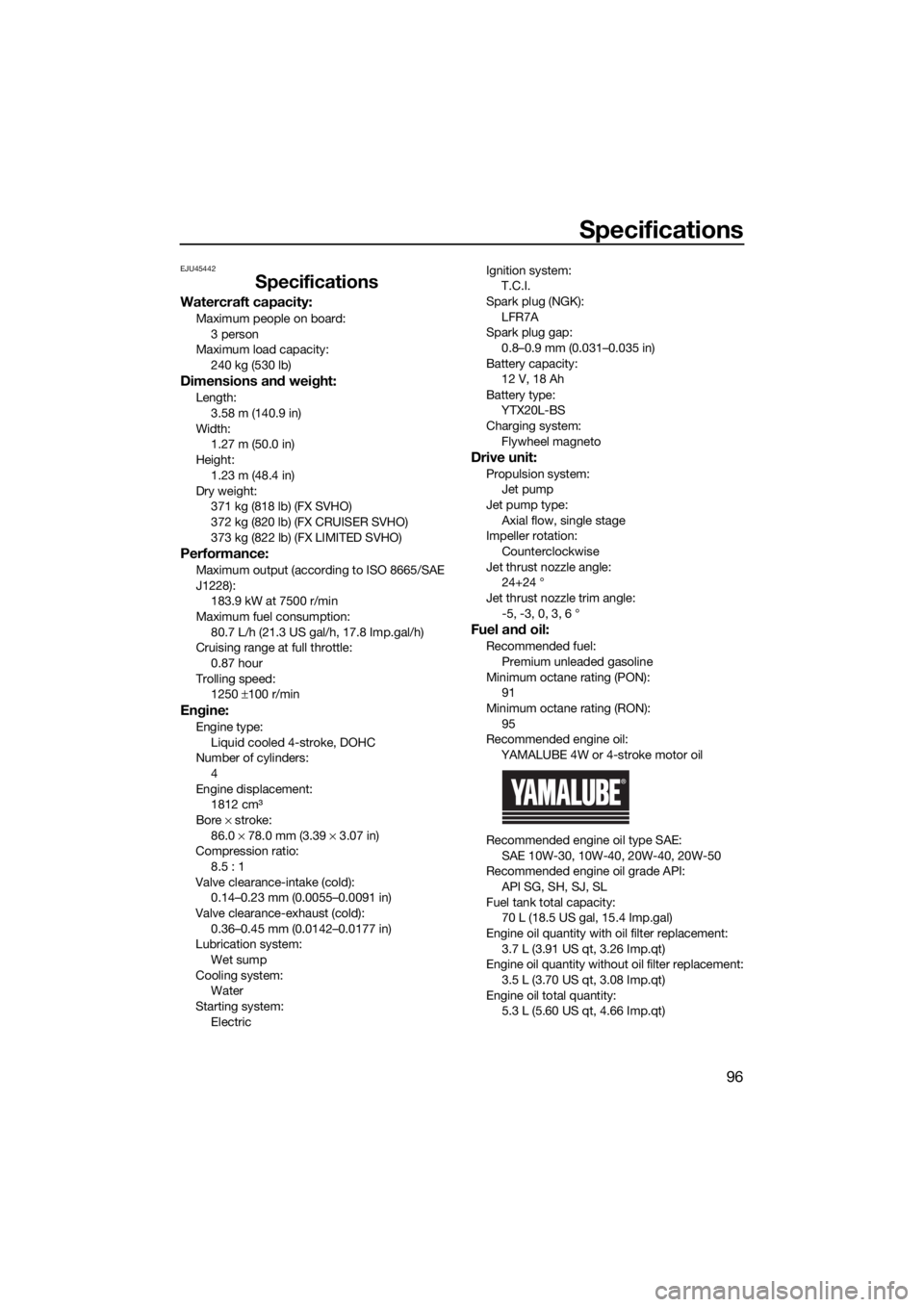
Specifications
96
EJU45442
Specifications
Watercraft capacity:
Maximum people on board:3 person
Maximum load capacity: 240 kg (530 lb)
Dimensions and weight:
Length:
3.58 m (140.9 in)
Width: 1.27 m (50.0 in)
Height: 1.23 m (48.4 in)
Dry weight: 371 kg (818 lb) (FX SVHO)
372 kg (820 lb) (FX CRUISER SVHO)
373 kg (822 lb) (FX LIMITED SVHO)
Performance:
Maximum output (according to ISO 8665/SAE
J1228):183.9 kW at 7500 r/min
Maximum fuel consumption: 80.7 L/h (21.3 US gal/h, 17.8 Imp.gal/h)
Cruising range at full throttle:
0.87 hour
Trolling speed: 1250 ±100 r/min
Engine:
Engine type:
Liquid cooled 4-stroke, DOHC
Number of cylinders: 4
Engine displacement: 1812 cm³
Bore × stroke:
86.0 × 78.0 mm (3.39 × 3.07 in)
Compression ratio: 8.5 : 1
Valve clearance-intake (cold): 0.14–0.23 mm (0.0055–0.0091 in)
Valve clearance-exhaust (cold):
0.36–0.45 mm (0.0142–0.0177 in)
Lubrication system: Wet sump
Cooling system: Water
Starting system:
Electric Ignition system:
T.C.I.
Spark plug (NGK): LFR7A
Spark plug gap:
0.8–0.9 mm (0.031–0.035 in)
Battery capacity: 12 V, 18 Ah
Battery type: YTX20L-BS
Charging system:
Flywheel magneto
Drive unit:
Propulsion system:Jet pump
Jet pump type: Axial flow, single stage
Impeller rotation:
Counterclockwise
Jet thrust nozzle angle: 24+24 °
Jet thrust nozzle trim angle: -5, -3, 0, 3, 6 °
Fuel and oil:
Recommended fuel:Premium unleaded gasoline
Minimum octane rating (PON): 91
Minimum octane rating (RON):
95
Recommended engine oil: YAMALUBE 4W or 4-stroke motor oil
Recommended engine oil type SAE: SAE 10W-30, 10W-40, 20W-40, 20W-50
Recommended engine oil grade API:
API SG, SH, SJ, SL
Fuel tank total capacity: 70 L (18.5 US gal, 15.4 Imp.gal)
Engine oil quantity with oil filter replacement: 3.7 L (3.91 US qt, 3.26 Imp.qt)
Engine oil quantity without oil filter replacement:
3.5 L (3.70 US qt, 3.08 Imp.qt)
Engine oil total quantity: 5.3 L (5.60 US qt, 4.66 Imp.qt)
UF3X72E0.book Page 96 Friday, May 29, 2020 10:09 AM
Page 104 of 116

Trouble recovery
97
EJU34562
Troubleshooting
If you have any trouble with your watercraft, use the troubleshooting chart to check for the
possible cause.
If you cannot find the cause, consult a Yamaha dealer.
EJU45280Troubleshooting chart
Confirm the possible cause and remedy, and then refer to the applicable page.
TROUBLEPOSSIBLE CAUSE REMEDYPAGE
Engine does not
start (Starter motor
does not turn over) Ya m a h a S e -
curity System
Lock mode selected Select unlock mode
25
Engine shut-
off switch Clip not in place Install clip
26
Fuse Burned out Replace fuse and
check wiring 102
Battery Run down Recharge87
Poor terminal con-
nections Tighten as required
87
Terminal corroded Clean or replace 87
Starter motor Faulty Have serviced by
Yamaha dealer —
Engine does not
start (Starter motor
turns over) Throttle lever Squeezed
Release26
Faulty Have serviced by
Yamaha dealer —
RiDE lever Squeezed Release26
Faulty Have serviced by
Yamaha dealer —
Fuel Fuel tank empty Refill as soon as pos-
sible 57
Stale or contaminat-
ed Have serviced by
Yamaha dealer
—
Fuel tank Water or dirt present Have serviced by Yamaha dealer—
Spark plug Fouled or defective Have serviced by Yamaha dealer—
Fuel injec-
tion system Fuel pump faulty Have serviced by
Yamaha dealer —
UF3X72E0.book Page 97 Friday, May 29, 2020 10:09 AM
Page 105 of 116

Trouble recovery
98
Engine runs irregu-
larly or stallsFuel Fuel tank empty Refill as soon as pos-
sible57
Stale or contaminat-
ed Have serviced by
Yamaha dealer
—
Incorrect octane
number Use correct fuel
57
Fuel tank Water or dirt present Have serviced by Yamaha dealer—
Spark plug Fouled or defective Have serviced by Yamaha dealer—
Incorrect heat range Have serviced by Yamaha dealer —
Gap incorrect Have serviced by Yamaha dealer —
Electrical wir-
ing Loose connection Have serviced by
Yamaha dealer —
Fuel injec-
tion system Faulty or clogged in-
jectors Have serviced by
Yamaha dealer
—
Warning is dis-
played Fuel level
warningFuel tank empty Refill as soon as pos-
sible 57
Oil pressure
warning Oil pressure dropped Have serviced by
Yamaha dealer 48
Engine over-
heat warning Jet intake clogged Clean
100
Check en-
gine warning Faulty sensors Have serviced by
Yamaha dealer 47
TROUBLE POSSIBLE CAUSE REMEDY PAGE
UF3X72E0.book Page 98 Friday, May 29, 2020 10:09 AM
Page 106 of 116

Trouble recovery
99
Watercraft slow or
loses powerWatercraft
operation
modeDrive control mode
activated
Deactivate or adjust
drive control mode 36
Cavitation Jet intake clogged Clean 100 Impeller damaged or
worn Have serviced by
Yamaha dealer
100
Engine over-
heat warning Engine speed reduc-
tion control activated Clean jet intake and
cool engine
47
Oil pressure
warning Engine speed reduc-
tion control activated Add oil
48
Spark plug Fouled or defective Have serviced by Yamaha dealer—
Incorrect heat range Have serviced by Yamaha dealer —
Gap incorrect Have serviced by Yamaha dealer —
Electrical wir-
ing Loose connection Have serviced by
Yamaha dealer —
Fuel Stale or contaminat- ed Have serviced by
Yamaha dealer
—
Incorrect octane
number Use correct fuel
57
Air filter Clogged Have serviced by Yamaha dealer—
Oil buildup Have serviced by Yamaha dealer —
Throttle lever Faulty Have serviced by Yamaha dealer—
TROUBLE POSSIBLE CAUSE REMEDY PAGE
UF3X72E0.book Page 99 Friday, May 29, 2020 10:09 AM
Page 107 of 116

Trouble recovery
100
EJU34625
Emergency proceduresEJU44590Cleaning the jet intake and impellerEWJ00783
Before attempting to remove weeds or de-
bris from the jet intake or impeller area,
shut the engine off and remove the clip
from the engine shut-off switch. Severe in-
jury or death could result from coming in
contact with the rotating parts of the jet
pump.
If weeds or debris gets caught in the jet intake
or impeller, cavitation can occur, causing jet
thrust to decrease even though engine speed
rises. If this condition is allowed to continue,
the engine will overheat and may seize.
NOTICE: If weeds or debris gets caught in
the jet intake, do not operate the water-
craft above trolling speed until they have
been removed.
[ECJ00654]
If there is any sign that the jet intake or impel-
ler is clogged with weeds or debris, return to
shore and check the intake and impeller. Al- ways stop the engine before beaching the
watercraft.
(1) Place a suitable clean cloth or carpeting
underneath the watercraft to protect it
from abrasions and scratches. Turn the
watercraft on its side as shown.
NOTICE: When turning the watercraft
on its side, support the bow so that
the handlebars are not bent or dam-
aged.
[ECJ02690]
(2) Remove any weeds or debris from around the jet intake, drive shaft, impel-
UF3X72E0.book Page 100 Friday, May 29, 2020 10:09 AM
Page 108 of 116
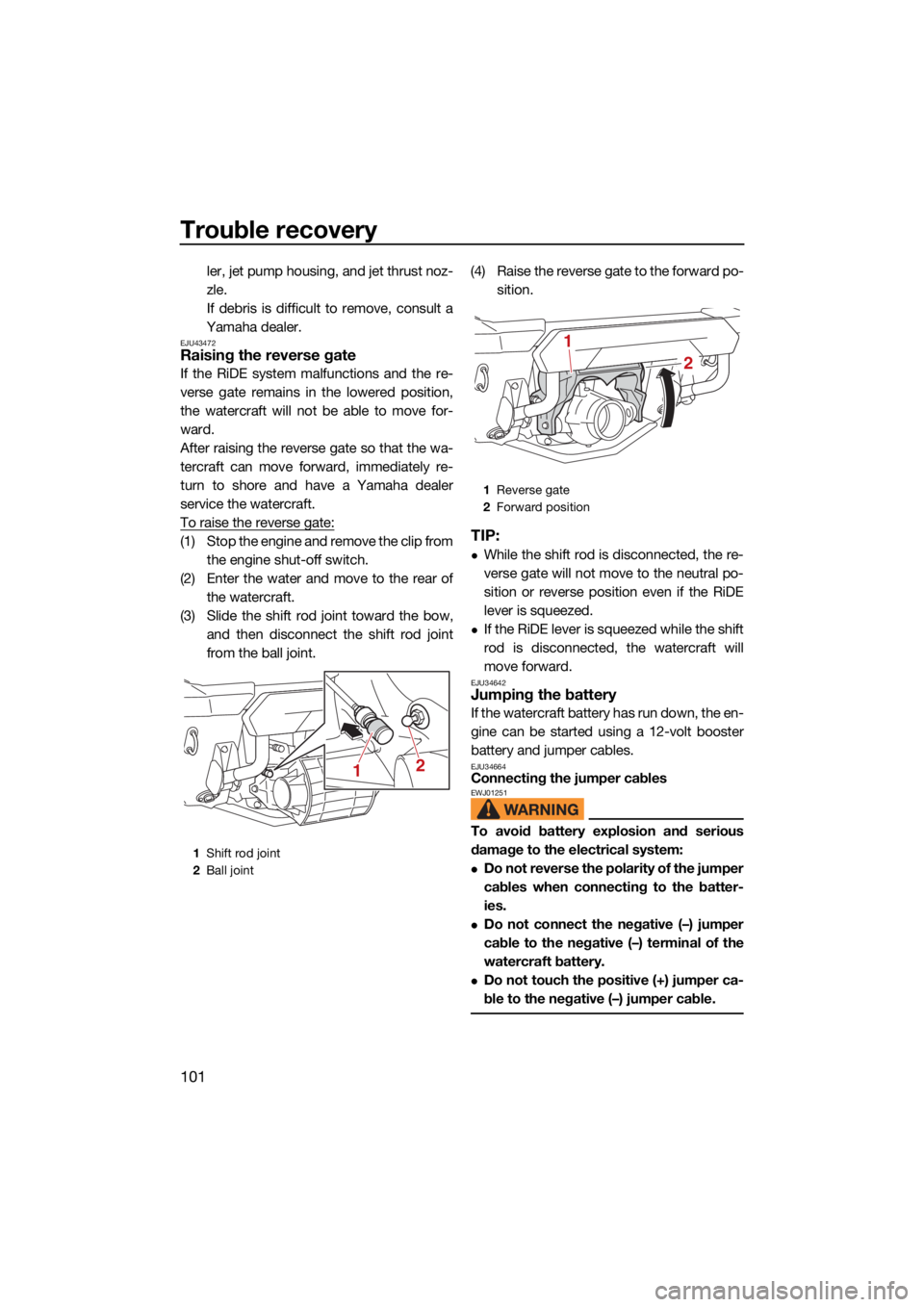
Trouble recovery
101
ler, jet pump housing, and jet thrust noz-
zle.
If debris is difficult to remove, consult a
Yamaha dealer.
EJU43472Raising the reverse gate
If the RiDE system malfunctions and the re-
verse gate remains in the lowered position,
the watercraft will not be able to move for-
ward.
After raising the reverse gate so that the wa-
tercraft can move forward, immediately re-
turn to shore and have a Yamaha dealer
service the watercraft.
To raise the reverse gate:
(1) Stop the engine and remove the clip from the engine shut-off switch.
(2) Enter the water and move to the rear of the watercraft.
(3) Slide the shift rod joint toward the bow, and then disconnect the shift rod joint
from the ball joint. (4) Raise the reverse gate to the forward po-
sition.TIP:
While the shift rod is disconnected, the re-
verse gate will not move to the neutral po-
sition or reverse position even if the RiDE
lever is squeezed.
If the RiDE lever is squeezed while the shift
rod is disconnected, the watercraft will
move forward.
EJU34642Jumping the battery
If the watercraft battery has run down, the en-
gine can be started using a 12-volt booster
battery and jumper cables.
EJU34664Connecting the jumper cablesEWJ01251
To avoid battery explosion and serious
damage to the electrical system:
Do not reverse the polarity of the jumper
cables when connecting to the batter-
ies.
Do not connect the negative (–) jumper
cable to the negative (–) terminal of the
watercraft battery.
Do not touch the positive (+) jumper ca-
ble to the negative (–) jumper cable.
1Shift rod joint
2 Ball joint
1 2
1
Reverse gate
2 Forward position
2
1
UF3X72E0.book Page 101 Friday, May 29, 2020 10:09 AM
Page 109 of 116
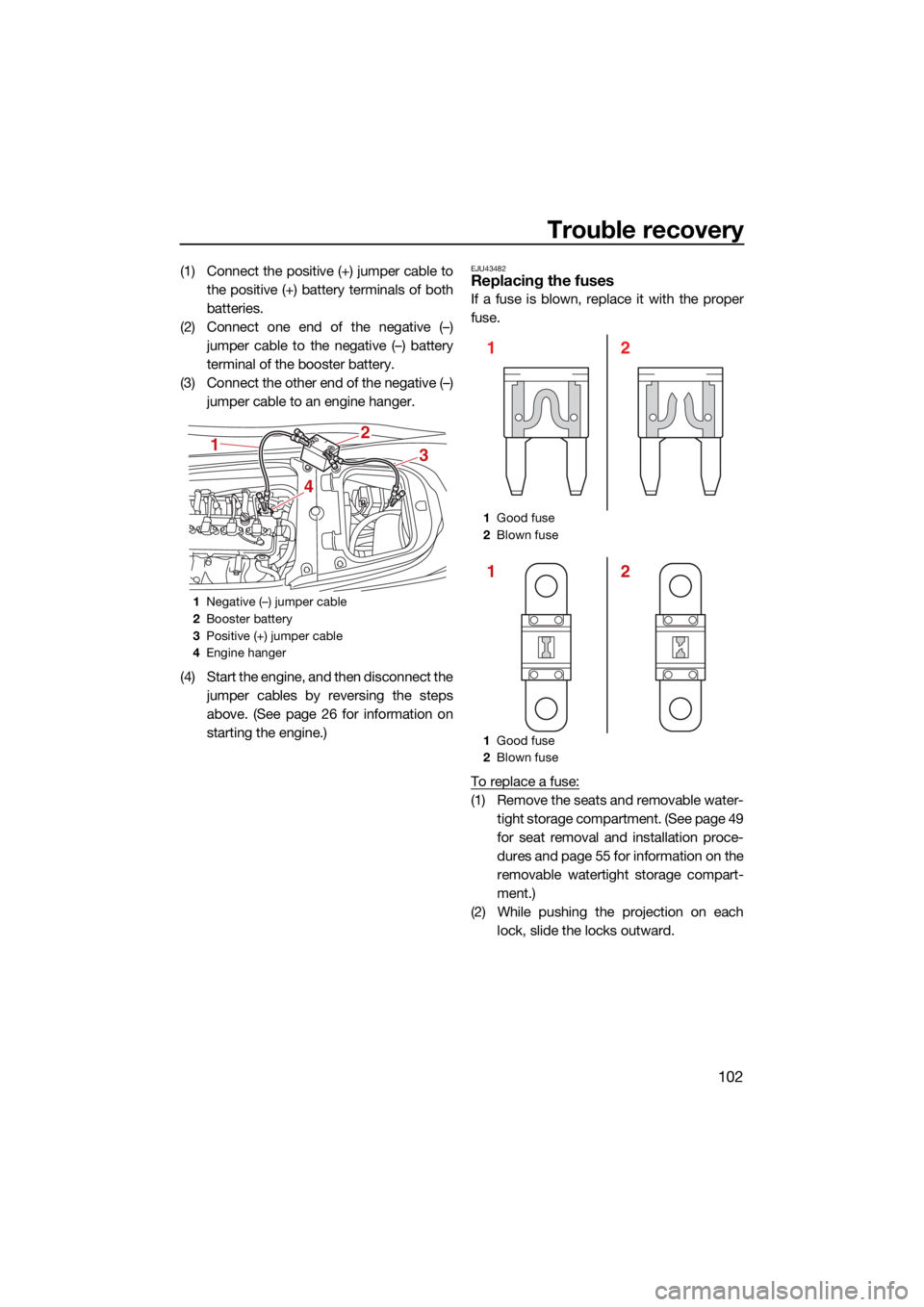
Trouble recovery
102
(1) Connect the positive (+) jumper cable tothe positive (+) battery terminals of both
batteries.
(2) Connect one end of the negative (–) jumper cable to the negative (–) battery
terminal of the booster battery.
(3) Connect the other end of the negative (–) jumper cable to an engine hanger.
(4) Start the engine, and then disconnect the jumper cables by reversing the steps
above. (See page 26 for information on
starting the engine.)EJU43482Replacing the fuses
If a fuse is blown, replace it with the proper
fuse.
To replace a fuse:
(1) Remove the seats and removable water-tight storage compartment. (See page 49
for seat removal and installation proce-
dures and page 55 for information on the
removable watertight storage compart-
ment.)
(2) While pushing the projection on each lock, slide the locks outward.
1Negative (–) jumper cable
2 Booster battery
3 Positive (+) jumper cable
4 Engine hanger
1
4
3
2
1Good fuse
2 Blown fuse
1 Good fuse
2 Blown fuse
2
1
2
1
UF3X72E0.book Page 102 Friday, May 29, 2020 10:09 AM
Page 110 of 116
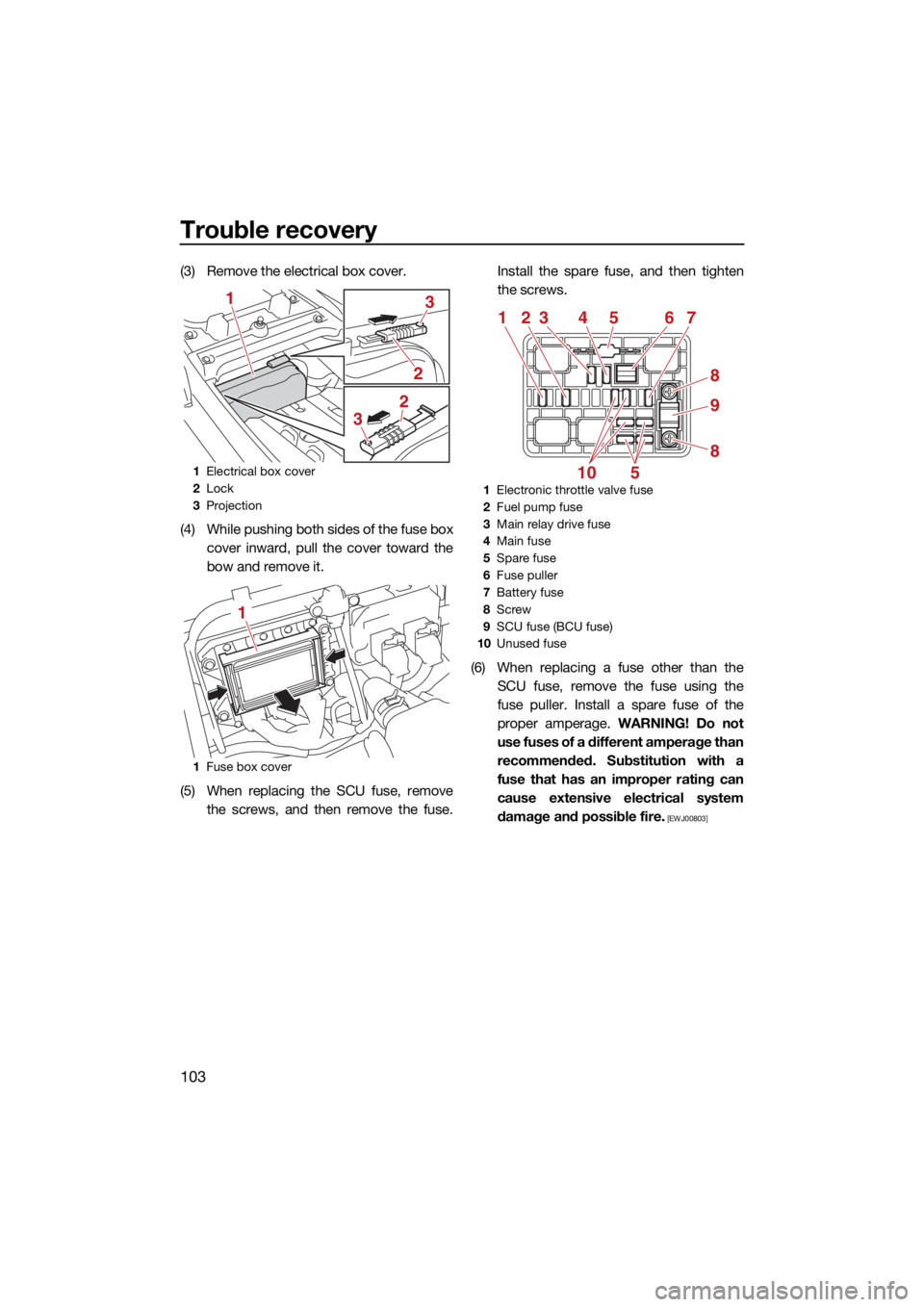
Trouble recovery
103
(3) Remove the electrical box cover.
(4) While pushing both sides of the fuse boxcover inward, pull the cover toward the
bow and remove it.
(5) When replacing the SCU fuse, remove the screws, and then remove the fuse. Install the spare fuse, and then tighten
the screws.
(6) When replacing a fuse other than the SCU fuse, remove the fuse using the
fuse puller. Install a spare fuse of the
proper amperage. WARNING! Do not
use fuses of a different amperage than
recommended. Substitution with a
fuse that has an improper rating can
cause extensive electrical system
damage and possible fire.
[EWJ00803]
1 Electrical box cover
2 Lock
3 Projection
1 Fuse box cover
2
3
2
3
1
1
1Electronic throttle valve fuse
2 Fuel pump fuse
3 Main relay drive fuse
4 Main fuse
5 Spare fuse
6 Fuse puller
7 Battery fuse
8 Screw
9 SCU fuse (BCU fuse)
10 Unused fuse
1
5
23 4 5 6 7
8
9
8
10
UF3X72E0.book Page 103 Friday, May 29, 2020 10:09 AM